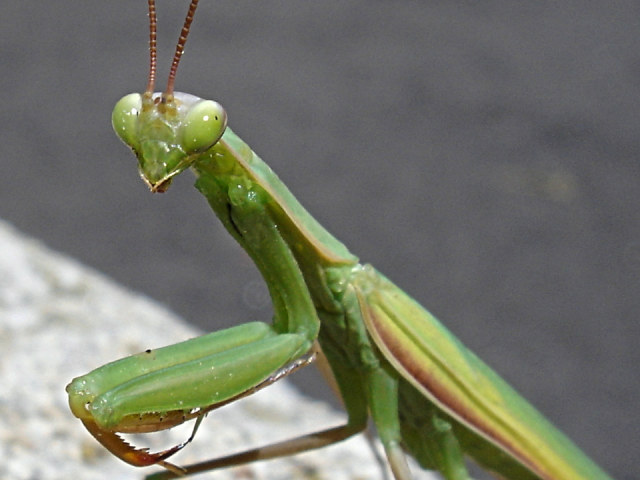
We found this praying mantis at the back of the office. Paul picked it up, but it flew off. It didn’t seem to mind having its picture taken.
This (my second) mantis sighting was much more interactive than my first.
work as if you live in the early days of a better nation

We found this praying mantis at the back of the office. Paul picked it up, but it flew off. It didn’t seem to mind having its picture taken.
This (my second) mantis sighting was much more interactive than my first.
A garden spider had built a large and elaborate web between the fence and the green bin. It looked happy there, and I was sad to dislodge it to take the recycling out.
Strange that the supposedly deep green Viridian Design online store only features one organic item out of twenty six on sale …
I’m reading McDonough & Braungart’s book Cradle To Cradle, and it makes me sneeze.
Not that the content is to be sneezed at — it’s a very sensible treatise on a zero-waste, EPR-based society. It’s not the polymer that the book is made from, either. It’s the fact that the a previous borrower of the book from the Toronto Public Library was the owner of a probably very attractive grey cat.
I’m allergic to most cats. And this isn’t usually a problem with library books, as paper doesn’t attract hair. But the polypropylene pages of Cradle To Cradle do, and so reading this book makes me itch. I guess this wouldn’t be a problem if I’d bought my own copy, but it’s a deal more environmentally responsible to share a few copies amongst the thousands of library patrons than keep one for myself.
I don’t necessarily agree with some of the arguments made about the upcyclability (that is, a product that can be recycled into something of an equal or higher quality) of the book. Basic entropy tells you that you can’t reform a product without losing something of the original. Some of the material will evaporate, or the filler will degrade somewhat, or some additional colourant will be required to restore the original tone.
Some other things that don’t jibe:
In fairness, mad props for McDonough’s work on green roofs, and to Melcher Media for giving the plastic book a try. But thinking that a few polymer pages will change the world is pushing credibility to its limits.
[And I really should temper the madness of my props to Melcher, as it would appear that they’re trying to patent the plastic book. I’m sure there’s some iota of novelty in replacing the form-factor and access methods of a cellulose polymer book with a hydrocarbon polymer, but for the life of me, I can’t find it.]

(click on the image for larger versions)
Ford Canada really have excelled themselves with the Escape Hybrid. It’s a great big huge SUV, but that doesn’t matter because it’s one of those lovely clean hybrids. Yes, that’s right, you can feel good about driving it, because you’re only supporting repressive regimes a bit.
But the best bit is in the writeup (emphasis mine):
Giving back to the environment doesn’t just stop at printing this advertisement on recyclable paper. …
C’mon guys, it’s just a regular car glossy. All paper is recyclable. If you’d have printed it on recycled hemp paper using vegetable inks, maybe, just maybe, you’d be giving something back. But this is just a sop to the car-besotted consumer.
As they go on to say: We keep thinking about the environment.
There’s a huge gap between just thinking, and actually doing something useful.
I got some spam^H^H^H^Htargeted marketing e-mail from thegreenwebhost.ca. Their prices seem deeply off; they charge C$109.95 (about US$83) for 7.5 gig monthly transfer, 2 gig storage and 100 e-mail addresses.
By comparison, I pay 1and1 US$10/month for 50 GB monthly transfer volume, 2,000 MB web space and 500 POP3 accounts.
While I’d consider paying a premium of perhaps up to 50% for green consumer items, there’s no way I’m paying more than 8× the price.